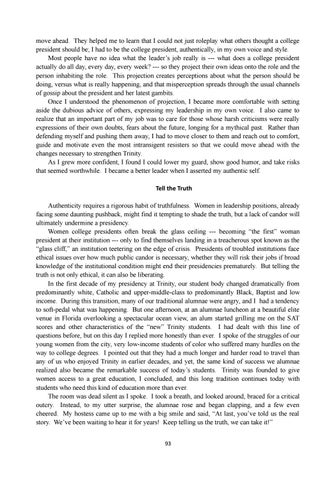move ahead. They helped me to learn that I could not just roleplay what others thought a college president should be; I had to be the college president, authentically, in my own voice and style. Most people have no idea what the leader’s job really is --- what does a college president actually do all day, every day, every week? --- so they project their own ideas onto the role and the person inhabiting the role. This projection creates perceptions about what the person should be doing, versus what is really happening, and that misperception spreads through the usual channels of gossip about the president and her latest gambits. Once I understood the phenomenon of projection, I became more comfortable with setting aside the dubious advice of others, expressing my leadership in my own voice. I also came to realize that an important part of my job was to care for those whose harsh criticisms were really expressions of their own doubts, fears about the future, longing for a mythical past. Rather than defending myself and pushing them away, I had to move closer to them and reach out to comfort, guide and motivate even the most intransigent resisters so that we could move ahead with the changes necessary to strengthen Trinity. As I grew more confident, I found I could lower my guard, show good humor, and take risks that seemed worthwhile. I became a better leader when I asserted my authentic self. Tell the Truth Authenticity requires a rigorous habit of truthfulness. Women in leadership positions, already facing some daunting pushback, might find it tempting to shade the truth, but a lack of candor will ultimately undermine a presidency. Women college presidents often break the glass ceiling --- becoming “the first” woman president at their institution --- only to find themselves landing in a treacherous spot known as the “glass cliff,” an institution teetering on the edge of crisis. Presidents of troubled institutions face ethical issues over how much public candor is necessary, whether they will risk their jobs if broad knowledge of the institutional condition might end their presidencies prematurely. But telling the truth is not only ethical, it can also be liberating. In the first decade of my presidency at Trinity, our student body changed dramatically from predominantly white, Catholic and upper-middle-class to predominantly Black, Baptist and low income. During this transition, many of our traditional alumnae were angry, and I had a tendency to soft-pedal what was happening. But one afternoon, at an alumnae luncheon at a beautiful elite venue in Florida overlooking a spectacular ocean view, an alum started grilling me on the SAT scores and other characteristics of the “new” Trinity students. I had dealt with this line of questions before, but on this day I replied more honestly than ever. I spoke of the struggles of our young women from the city, very low-income students of color who suffered many hurdles on the way to college degrees. I pointed out that they had a much longer and harder road to travel than any of us who enjoyed Trinity in earlier decades, and yet, the same kind of success we alumnae realized also became the remarkable success of today’s students. Trinity was founded to give women access to a great education, I concluded, and this long tradition continues today with students who need this kind of education more than ever. The room was dead silent as I spoke. I took a breath, and looked around, braced for a critical outcry. Instead, to my utter surprise, the alumnae rose and began clapping, and a few even cheered. My hostess came up to me with a big smile and said, “At last, you’ve told us the real story. We’ve been waiting to hear it for years! Keep telling us the truth, we can take it!” 93
Issuu converts static files into: digital portfolios, online yearbooks, online catalogs, digital photo albums and more. Sign up and create your flipbook.
